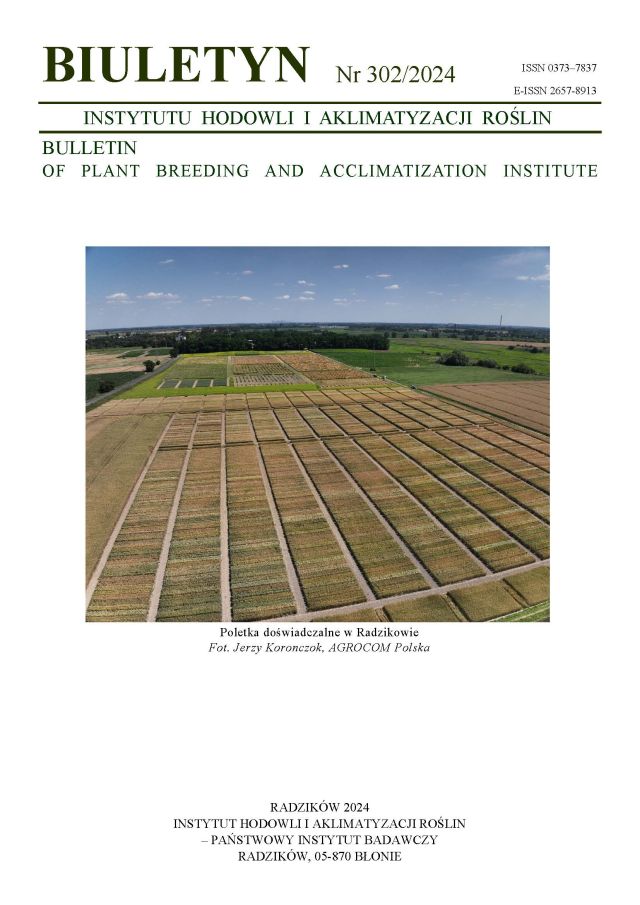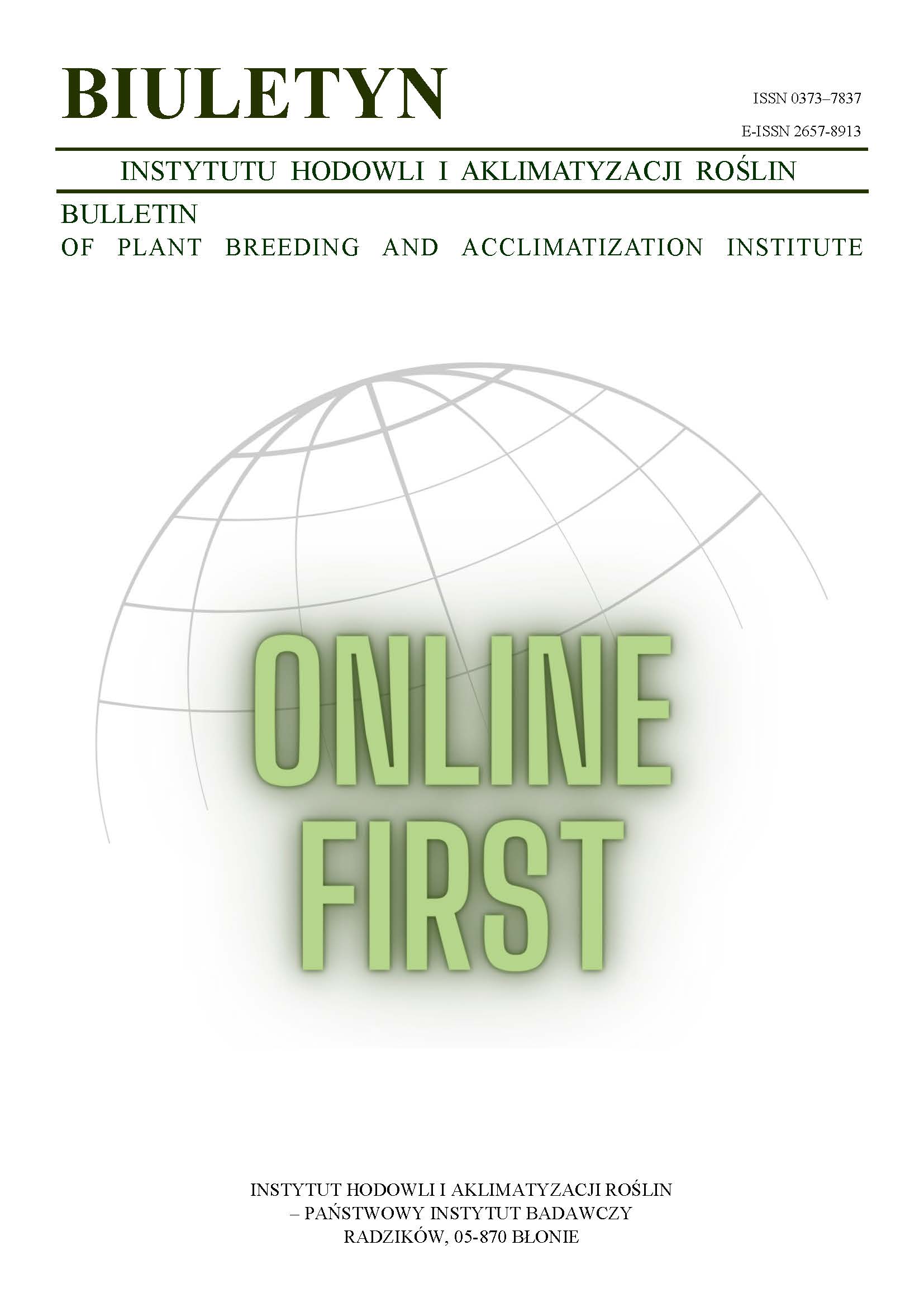Effect of distance from the pollen source on seed set in male sterile triticale lines
Halina Góral
khrin@urk.edu.plKatedra Hodowli Roślin i Nasiennictwa, Akademia Rolnicza w Krakowie (Poland)
Abstract
Six winter triticale male sterile lines, based on the Triticum timopheevi cytoplasm, and 9 pollen parents were used in testing the effect of distance from the pollen source on the amount of pollen in the air and on the seed set in female ears, as well as in testing the effect of flowering synchronization on seed set. The experiments were carried out in 2001–2002. In both years the proportion of females to males was 3:1. The strip width of females and males was 8.1 and 2.7 m in 2001, and 18 and 6 m in 2002, respectively. Only one female line flowered synchronously with male parents, others flowered later up to 5 days. The highest amount of pollen on pollen traps and seed set in female lines was in the distance of 0.6 m from the ears of male parents. Starting from a distance of 2.6 m from male parents the amount of pollen on pollen traps and seed set in male sterile females was significantly lower, regardless of the strip width. The seed set depended on the flowering synchronization of females and males.
Keywords:
Triticum timopheevi, male sterility, seed set, triticale, pollinationReferences
Góral H. 2002 a. Production of triticale (X Triticosecale Wittm.) hybrid seeds using the sterilizing cytoplasm of Triticum timopheevi. Cereal Res. Com. 30: 31 — 38.
DOI: https://doi.org/10.1007/BF03543386
Google Scholar
Góral H. 2002 b. Biologiczno-hodowlane aspekty wykorzystania heterozji u pszenżyta (X Triticosecale Wittmack). Zesz. Nauk. AR w Krakowie, ser. Rozprawy, nr 283.
Google Scholar
Hughes J. L., Sapra V. T., Sharma G. C. 1976. Cross-pollination in hexaploid triticale. Cereal Res. Com. 4 (3): 355 — 362.
Google Scholar
Kociuba W., Skulimowska R. 1995. Obserwacje kwitnienia, zapylenia i płodności roślin pszenżyta w porównaniu do pszenicy i żyta. Biul. IHAR 195/196: 99 — 106.
Google Scholar
Sowa W. Krysiak H. 1994. Ocena odmian pszenżyta pod względem skłonności do obcozapylenia. Biul. IHAR 192: 23 — 28.
Google Scholar
Tarkowski C. Kociuba W. 1989. Biologia kwitnienia. W: Biologia pszenżyta. Red. C. Tarnowski, PWN, Warszawa: 99 — 110.
Google Scholar
Warzecha R., Salak-Warzecha K. 2002. Hybrid triticale — prospects for research and breeding — Part II: Development of male sterile lines. Proc. 5th Int. Triticale Symp. IHAR Radzików, Poland, 30 June–5 July 2002, vol. I: 193 — 198.
Google Scholar
Woś H., Góral H., Woś B., Spiss L. 2002. Heterosis in winter triticale with T. timopheevi cytoplasm. Proc. 5th Int. Triticale Symp., IHAR Radzików, Poland, 30 June — 5 July 2002, vol. II: 311 — 315.
Google Scholar
Yeung K. C., Larter E. N. 1972. Pollen production and disseminating properties of triticale relative to wheat. Can. J. Plant Sci. 52: 569 — 574.
DOI: https://doi.org/10.4141/cjps72-088
Google Scholar
Authors
Halina Góralkhrin@urk.edu.pl
Katedra Hodowli Roślin i Nasiennictwa, Akademia Rolnicza w Krakowie Poland
Statistics
Abstract views: 91PDF downloads: 18
License
Copyright (c) 2004 Halina Góral

This work is licensed under a Creative Commons Attribution-ShareAlike 4.0 International License.
Upon submitting the article, the Authors grant the Publisher a non-exclusive and free license to use the article for an indefinite period of time throughout the world in the following fields of use:
- Production and reproduction of copies of the article using a specific technique, including printing and digital technology.
- Placing on the market, lending or renting the original or copies of the article.
- Public performance, exhibition, display, reproduction, broadcasting and re-broadcasting, as well as making the article publicly available in such a way that everyone can access it at a place and time of their choice.
- Including the article in a collective work.
- Uploading an article in electronic form to electronic platforms or otherwise introducing an article in electronic form to the Internet or other network.
- Dissemination of the article in electronic form on the Internet or other network, in collective work as well as independently.
- Making the article available in an electronic version in such a way that everyone can access it at a place and time of their choice, in particular via the Internet.
Authors by sending a request for publication:
- They consent to the publication of the article in the journal,
- They agree to give the publication a DOI (Digital Object Identifier),
- They undertake to comply with the publishing house's code of ethics in accordance with the guidelines of the Committee on Publication Ethics (COPE), (http://ihar.edu.pl/biblioteka_i_wydawnictwa.php),
- They consent to the articles being made available in electronic form under the CC BY-SA 4.0 license, in open access,
- They agree to send article metadata to commercial and non-commercial journal indexing databases.
Most read articles by the same author(s)
- Stefan Stojałowski , Marta Orłowska , Martyna Sobczyk , Anna Bienias , Marcin Berdzik , Beata Myśków , Halina Góral , Magdalena Simlat , Tomasz Warzecha , Wojciech Wesołowski , Marek Szklarczyk , Mirosław Pojmaj , Genetic background of male sterility in triticale with different cytoplasm’s and perspectives of it utilization for development of CMS system in wheat , Bulletin of Plant Breeding and Acclimatization Institute: No. 286 (2019): Special issue
- Halina Góral, Male fertility of winter triticale depending on the cytoplasm and male parent , Bulletin of Plant Breeding and Acclimatization Institute: No. 269 (2013): Regular issue
- Halina Góral, Maciej Ejsmond, Combining ability analysis and heritability of yield components in linseed (Linum usitatissimum L.) , Bulletin of Plant Breeding and Acclimatization Institute: No. 249 (2008): Regular issue
- Halina Góral, Mirosław Pojmaj, Renata Pojmaj, Monika Burczy, Production of hybrid seeds of winter triticale from cms and restoring lines in strip and bulk sowing , Bulletin of Plant Breeding and Acclimatization Institute: No. 252 (2009): Regular issue
- Halina Góral, Mirosław Pojmaj, Renata Pojmaj, Frequency of maintainer and restorer genotypes for the cms-T. timopheevi system winter triticale , Bulletin of Plant Breeding and Acclimatization Institute: No. 244 (2007): Regular issue
- Elżbieta Pisulewska, Julita Maciejewicz-Ryś, Halina Góral, Yield, chemical composition and protein quality in long flower head forms of red clover (Trifolium pratense L.) , Bulletin of Plant Breeding and Acclimatization Institute: No. 228 (2003): Regular issue
- Tomasz Warzecha, Halina Góral, Susceptibility of auto- and alloplasmic triticale lines to seedling blight caused by Fusarium culmorum (W.G.Sm.) Sacc. , Bulletin of Plant Breeding and Acclimatization Institute: No. 236 (2005): Regular issue
- Halina Góral, Jadwiga Przypadek, Ludwik Spiss, Selection of red clover (Trifolium pratense L.) with regard to length and number of flower heads , Bulletin of Plant Breeding and Acclimatization Institute: No. 226/227 (2003): Regular issue
- Halina Góral, Ludwik Spiss, Development of maintainer and restorer genotypes for cms-T. timopheevi system in spring triticale , Bulletin of Plant Breeding and Acclimatization Institute: No. 236 (2005): Regular issue
- Tomasz Warzecha, Halina Góral, Combining ability of cms lines, strains and cultivars of triticale for susceptibility to seedling blight caused by Fusarium culmorum , Bulletin of Plant Breeding and Acclimatization Institute: No. 240/241 (2006): Regular issue














